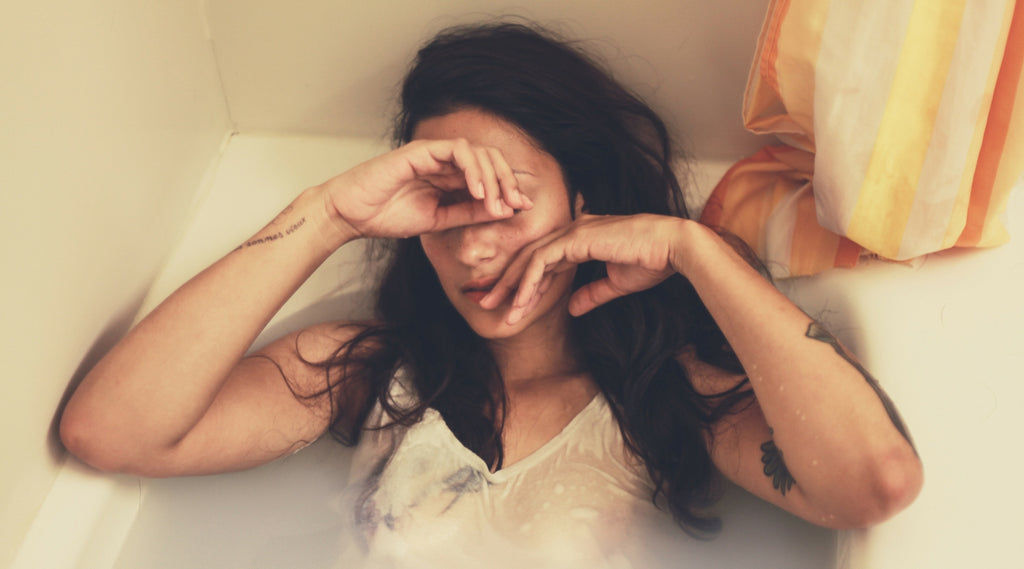Healthy Way - Am I Depressed Or Just In A Funk? Here’s How To Tell The Difference

Am I Depressed Or Just In A Funk?Here’s How To Tell The Difference
Most people think of depression as being sad all the time, but there’s a lot more to it than that. Here’s how to tell whether you’re depressed or in a funk.

When I was in my first year of university, I couldn’t figure out if I was miserable or depressed. I cried often, I struggled with my sleeping patterns, my immune system was weak, and I felt irritable and unmotivated all the time. Am I depressed? I wondered. Or am I just moody?
While I felt sad, it eventually became clear that it wasn’t a bad mood or a response to one specific life change—I had depression. And while help was available, I needed to acknowledge that I was depressed before anything could get better.
We often associate depression with sadness, and we often use the word depressing or depressed to mean very sad. Some people even use it to talk about relatively normal life events: “I’m so depressed he canceled our date!” or “This history class is so damn depressing.” For this reason, it can be difficult to tell whether you’re truly depressed or simply upset. Like me, you might be asking yourself, Am I depressed, or am I feeling sad, hopeless, or unmotivated?
Here’s what you need to know about the difference between depression and general sadness.
Am I depressed or am I sad?
Depression is a mental illness—a mood disorder, to be specific—while sadness is a mood or feeling. This distinction might seem simple, but if you’re struggling with a low mood, it can be hard to tell the difference.
That said, there are a few notable differences between depression and sadness or lack of motivation.
“In sadness, there are mostly feelings of emptiness and loss. In depression, there is a persistent depressed mood and inability to anticipate happiness or pleasure,” says Danielle Forshee, PsyD, LCSW, a practicing psychologist.
“Feelings associated with sadness are likely to decrease in intensity over the course of a few days or weeks and occur in waves,” Forshee adds. “These waves tend to be associated with thoughts or reminders of what it is that is making you sad. The depressed mood of depression is more persistent and not tied to specific thoughts. Usually thoughts in depression are associated with self-criticism or pessimism.”
In other words, when you’re sad, your sadness is associated with a specific issue. When you’re depressed, on the other hand, it’s chronic: It’s a lens that obscures the joy around you. Depression makes you struggle to find happiness or joy in your surroundings.
Something else to note, Forshee says, is that your self-esteem is usually relatively intact when you’re sad. With depression, on the other hand, it’s common to feel worthless or self-loathing.
If you’re asking yourself Am I depressed? consider which of those scenarios applies to you.
What causes depression?
Another key difference between sadness and depression is its cause. Sadness is usually caused by a certain event or issue, and while depression can be triggered by a specific situation, the true cause of depression is extremely complex.
You may have heard that depression is caused by a “chemical imbalance” in the brain. Many experts have pointed out that while this explanation isn’t exactly wrong, it’s a little oversimplified. “Depression isn’t likely caused by just one thing, but rather a complex interplay of many things such as genetic predisposition to having low moods, trauma and negative experiences, levels of concentrations of certain neurotransmitters, nerve cell connection function, and nerve circuit functioning,” explains neuropsychologist Amy Serin, PhD, founder of the Serin Center.
“There is a difference between sadness, which is often a temporary acute reaction to a difficult life situation,” says Serin, “and depression, which is a longer-lasting state in which a person can experience a loss of pleasure in life, fatigue, sleep changes, physical symptoms, feelings of worthlessness and hopelessness, and even suicidality.”
There can also be significant physiological differences between people who feel sad but are not struggling with depression and those who are depressed, including hormonal differences. “Stress plays a role in modulating depression,” Serin explains. “Individuals with emotional or physical stress produce more corticotropin-releasing hormone (CRH), a hormone that is often elevated in depressed individuals. When CRH returns to normal levels, mood states improve and depression lessens,” she says.
It’s important to remember that there are a number of physiological factors that come along with depression. An effective treatment program will address multiple facets of your experience to make depression more manageable, and professionals who are qualified to help treat depression know it isn’t as simple as changing your attitude, which is important for you to keep in mind too.
A common misconception about depression is that depressed people only experience sadness, all of the time. In reality, depression can include a range of negative emotions and even physical feelings including anger, numbness, lethargy, or irritability.
“Depression is a complex condition which may present differently across a range of people,” explains Lekeisha A. Sumner, Ph.D., a board-certified clinical psychologist. “Sadness may not be the most prominent symptom. For example, for some people it may present with more physical complaints or irritability than low mood.”
So, while depression is often accompanied by sadness, it’s certainly possible to feel other negative moods—annoyance, apathy, or demotivation, for example—more than sadness.
Instead of crying constantly, you might find yourself struggling to function and complete day-to-day tasks, or you might be easily annoyed or upset, or you might struggle to find the joy in the things that previously brought you pleasure.
Depression isn’t just about how you feel—it’s also linked to a number of physical symptoms. “Many people with depression show up in their doctor’s offices with vague pain that can include chronic joint pain, limb pain, back pain, gastrointestinal problems, fatigue, sleep disturbances, and appetite changes,” Serin notes.
Serin explains that while most people believe there’s a strong division between mind and body, mental illnesses like depression—and even moods, like sadness—can affect the body profoundly. “We know that invoking even a small amount of sadness will increase someone’s level of perceived pain, so it makes sense that individuals with depression literally feel more physical symptoms than non-depressed people, even in the absence of other medical causes,” she says.
This might feel very overwhelming, especially since depression is linked to such a wide array of physical, mental, and emotional effects. But it’s important to remember that there’s a lot of hope for those who are depressed, and effective treatment will address your physical and emotional symptoms.
How is depression diagnosed?
If you find yourself asking Am I depressed?, the best person to help you work your way toward an answer is a trained expert.
“A professional can determine the subtleties among symptoms of major depression, dysthymia, grief, and normal sadness,” Sumner explains. “If you have been experiencing persistent sadness for at least two weeks, you would likely benefit from a professional evaluation,” she says.
According to Forshee, to meet criteria for major depressive disorder, symptoms of depression must have been present every single day for at least two weeks. The symptoms are:
- Depressed mood most of the day (feeling sad, empty, hopeless)
- Little or no pleasure in almost all activities that previously you derived pleasure from
- Significant weight loss/decrease or increase in appetite nearly every day
- Sleeping way too much or not sleeping at all
- Feeling physically slowed down
- Feeling very fatigued or having a loss of energy nearly every day
- Feelings of worthlessness or excessive and inappropriate guilt nearly every day
- Limited ability to think/concentrate or indecisiveness nearly every day
- Recurring thoughts of death, suicidal thoughts without a plan, or a suicide attempt, or having a plan for committing suicide
Other types of depression include:
- Bipolar disorder
- Seasonal affective disorder (SAD)
- Postpartum depression
- Premenstrual dysphoric disorder (PMDD)
Even if you don’t consistently experience all the symptoms associated with major depression or don’t think you’ll be diagnosed with another type of depression, you should still talk to a professional if you’re struggling with your mental health. You don’t need a diagnosis in order to receive help; therapy can benefit people whether they have a diagnosed mental illness or not.
Many people think they can simply cure depression on their own if they just have a positive attitude. While staying positive is a great start, depression is a medical condition and it should be approached as such. We all need a little help sometimes, and there’s no shame in seeking help if you think you may be depressed. Just as you wouldn’t (or shouldn’t) attempt to cure appendicitis on your own, it’s important to look for professional help if you have depression.
If you think you may be depressed, your first port-of-call should be a therapist of some kind. If you have health insurance, you should be able to search in-network providers online through your insurer’s provider directory. (Note that they may be listed as behavioral health professionals.) If you’re unsure which therapist to visit, look for reviews online, ask for a recommendation from your general physician or friends, or try an online therapy portal like BetterHelp or Talkspace. Psychotherapy—that is, talk therapy—is a great way to improve and maintain your emotional health, whether you have a mental illness or not.
Sumner says that one of the most effective treatments for depression is cognitive behavioral therapy (CBT). “CBT is based on the premise that maladaptive cognitions, such as beliefs or paradigms about one’s world, surroundings, themselves, and the future, contribute to automatic thoughts that lead to distress,” she explains.
With CBT, a therapist can help you recognize these problematic beliefs, thought patterns, and behaviors so that you can change them. Changing your thought patterns and behaviors might help relieve your depression. Serin points out that CBT has been shown to literally alter the hippocampus in the brain, which provides further evidence that CBT is an effective treatment for those who are depressed.
So I’m depressed. What else can I do?
“It is important to note that neurochemicals associated with depression can be altered with treatments that are not medication,” Serin says. In other words, while medication can be necessary and life-saving for many people with depression, there are other treatment options that you can explore.
“Meditation, improved sleep, exercise, and other healthy behaviors have also been shown to reduce depression in many studies,” she says. Serin also recommends getting enough sleep, maintaining a healthy diet, and creating social connections with supportive people to maintain your mental health.
Of course, maintaining a healthy diet can be tough when you’re struggling with depression. Depression can affect your appetite, causing you to eat too much or too little. And even if you have an appetite, depression often means you don’t have the energy to cook healthy, filling food, causing you to resort to eating what the internet has lightheartedly dubbed “depression meals.”
When you have the energy to do so, you might find it helpful to stock your cupboard and fridge with easy-to-make food: tea, whole-grain bread, nut butter, protein shakes, fruit, and frozen veggies can all be your allies when it comes to addressing your depression. Try to freeze leftover soup and keep it in your freezer for emergencies. Don’t feel bad if you need to call for delivery, pick up takeout, or buy ready-made food: Eating anything is better than eating nothing at all.
If you find yourself wanting to focus on your feelings, Sumner recommends trying expressive writing through journaling, which can help you express and process your emotions. Some studies suggest that gratitude journaling can be used to boost one’s self-esteem and general well-being, not to mention writing your feelings down is a great way to remember what to discuss in your next therapy session!
In addition to all of these suggestions, Sumner recommends engaging with positive, supportive people. She also suggests you increase the pleasurable activities you engage in throughout the day. Take time to do the things that make you feel relaxed, happy, or excited. This could include taking a walk, reading, or watching a funny show. It can be hard to get yourself out of the house or even respond to texts when you’re in the throes of depression, but if you’re feeling up to it, these small things can help lift your mood.
While depression sometimes seems impossible to deal with, it can be treated effectively. Many people who have depression still manage to have happy, full, exciting lives—they just need to take extra good care of their mental health.
*This article first appeared in HealthyWay on May 1, 2018, by . To read the full article, click here.
TouchPoints are an at-home tool that can be incorporated into a healthy lifestyle to reduce the overall stress that often accompanies depression through the use of non-invasive neuroscientific technology.




